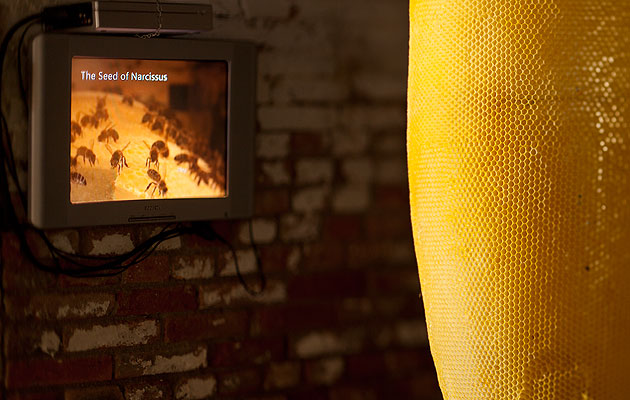|
|
||
|
Tomas Libertiny’s Honeycomb Vase was first presented at the Milan Furniture Fair in 2007 and is now in MoMA’s permanent collection. The Slovakian-born designer’s vase was the result of 40,000 bees making a hive around a wooden mould and then removing the honey to leave behind a clean beeswax structure. Now Libertiny and his apian friends have produced their largest project to date, a commission from Glasstress (see Icon 095) that is showing alongside the Venice Biennale. Libertiny sent in sketches for “two projects that were impossible to make” and like many before him soon realised that “there is a limit to what you can do in glass”. The project they eventually agreed on, called “The Seed of Narcissus”, is a 90cm-long glass torpedo, weighing roughly 10kg. The glass was handblown in a wooden mould and molten silver poured into it through a hole in the top. After cooling, the silver formed a layer 2 to 3cm thick, a mirror recalling the myth of Narcissus who fell in love with his own reflection. The finished object was shipped to Libertiny’s studio in Rotterdam, where it was placed in another wooden mould. Sixty thousand bees made a nest around it and, although it took them a month to warm to the task, “Once they grabbed the idea they did it within a week.” The method is a good way, Libertiny says, of getting the bees to do something with their downtime: “For them it’s not really a loss; if they do not build, they just procrastinate.” Of the beeswax, he says: “It’s like bonsai: you let it grow and you cut off certain branches and every now and then you check on it.” There’s a philosophical aspect to Libertiny’s work; he’s keen to avoid turning what he once half-jokingly referred to as “slow prototyping” into a novelty act. The parabolic form recalls both the form of wild hives and also the human body: “Originally I intended to do the form of a body. There is something in the form of the vase. It’s a story and it’s a beautiful story.”
|
Image Francesco Allegretto
Words Fatema Ahmed |
|
|
||

















